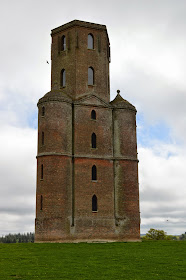Horton Tower was built in 1750 by the Lord of Horton Manor, Humphrey Sturt, who was an architect and also an MP for Dorset (1745 – 1786). The exact reason why the tower was built is unclear. The practice of folly building was popular in the 18th and 19th centuries, and often they were built purely to be admired as eye-catching constructions as opposed to having any real practical purpose. Horton Tower may have served a purpose however, with some suggesting that it was built to be used as an observatory for star gazing, whilst others suggest it was used by Humphrey Sturt to watch nearby hunts.
The brick tower has a triangular foot-print with round turrets at each corner and rises up to a height of 140 feet (43 metres), which supposedly made it the tallest non-religious building in England at the time of its construction. The tower’s shape and style is similar to that of King Alfred’s Tower on the Stourhead estate in Somerset, which was built in the 1760s. King Alfred’s tower measures in at a height of 161 feet (49 metres), and it is possible that it was built taller than Horton Tower in a purposeful act of one-upmanship.
The other piece of history related to the village of Horton, that is worthy of mention, is that it is the location where James Scott the 1st Duke of Monmouth was captured after the failed Monmouth Rebellion. Following the Duke’s defeat at the battle of Sedgemoor on the 6th July 1685, he fled towards Dorset where he is said to have hid in a ditch under an ash tree in Horton disguised as a shepherd. Sadly for the Duke his hiding place was disclosed by a local and he was captured on the 8th July, and then beheaded at Tower Hill in London on the 15th July. His beheading was not swift nor merciful; it apparently took between five and eight blows to cleave his head from his body!
For those that want to know more, the story of the Monmouth Rebellion features in Andrew May's Bloody British History Somerset, which is available on Amazon.
 |
| Horton Tower. |
Pictures: Dorset (May 2015).
If you find this post interesting please share it using the buttons below.



No comments:
Post a Comment